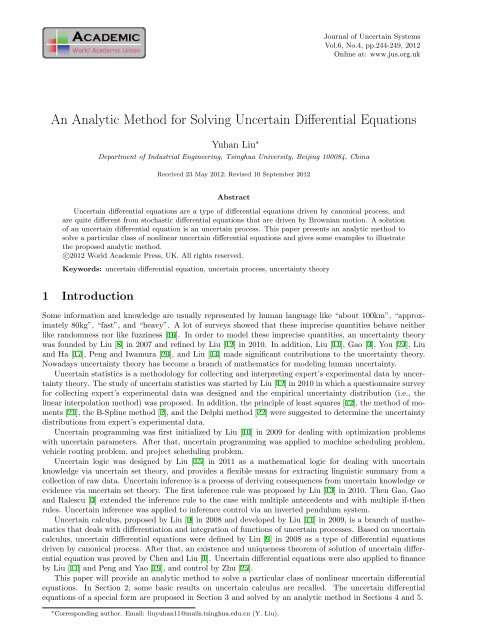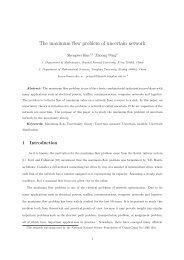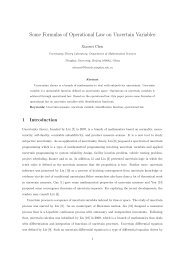An Analytic Method for Solving Uncertain Differential Equations
An Analytic Method for Solving Uncertain Differential Equations
An Analytic Method for Solving Uncertain Differential Equations
Create successful ePaper yourself
Turn your PDF publications into a flip-book with our unique Google optimized e-Paper software.
Journal of <strong>Uncertain</strong> Systems<br />
Vol.6, No.4, pp.244-249, 2012<br />
Online at: www.jus.org.uk<br />
<strong>An</strong> <strong>An</strong>alytic <strong>Method</strong> <strong>for</strong> <strong>Solving</strong> <strong>Uncertain</strong> <strong>Differential</strong> <strong>Equations</strong><br />
Yuhan Liu ∗<br />
Department of Industrial Engineering, Tsinghua University, Beijing 100084, China<br />
Received 23 May 2012; Revised 10 September 2012<br />
Abstract<br />
<strong>Uncertain</strong> differential equations are a type of differential equations driven by canonical process, and<br />
are quite different from stochastic differential equations that are driven by Brownian motion. A solution<br />
of an uncertain differential equation is an uncertain process. This paper presents an analytic method to<br />
solve a particular class of nonlinear uncertain differential equations and gives some examples to illustrate<br />
the proposed analytic method.<br />
c○2012 World Academic Press, UK. All rights reserved.<br />
Keywords: uncertain differential equation, uncertain process, uncertainty theory<br />
1 Introduction<br />
Some in<strong>for</strong>mation and knowledge are usually represented by human language like “about 100km”, “approximately<br />
80kg”, “fast”, and “heavy”. A lot of surveys showed that these imprecise quantities behave neither<br />
like randomness nor like fuzziness [16]. In order to model these imprecise quantities, an uncertainty theory<br />
was founded by Liu [8] in 2007 and refined by Liu [12] in 2010. In addition, Liu [11], Gao [3], You [24], Liu<br />
and Ha [17], Peng and Iwamura [20], and Liu [14] made significant contributions to the uncertainty theory.<br />
Nowadays uncertainty theory has become a branch of mathematics <strong>for</strong> modeling human uncertainty.<br />
<strong>Uncertain</strong> statistics is a methodology <strong>for</strong> collecting and interpreting expert’s experimental data by uncertainty<br />
theory. The study of uncertain statistics was started by Liu [12] in 2010 in which a questionnaire survey<br />
<strong>for</strong> collecting expert’s experimental data was designed and the empirical uncertainty distribution (i.e., the<br />
linear interpolation method) was proposed. In addition, the principle of least squares [12], the method of moments<br />
[21], the B-Spline method [2], and the Delphi method [22] were suggested to determine the uncertainty<br />
distributions from expert’s experimental data.<br />
<strong>Uncertain</strong> programming was first initialized by Liu [10] in 2009 <strong>for</strong> dealing with optimization problems<br />
with uncertain parameters. After that, uncertain programming was applied to machine scheduling problem,<br />
vehicle routing problem, and project scheduling problem.<br />
<strong>Uncertain</strong> logic was designed by Liu [15] in 2011 as a mathematical logic <strong>for</strong> dealing with uncertain<br />
knowledge via uncertain set theory, and provides a flexible means <strong>for</strong> extracting linguistic summary from a<br />
collection of raw data. <strong>Uncertain</strong> inference is a process of deriving consequences from uncertain knowledge or<br />
evidence via uncertain set theory. The first inference rule was proposed by Liu [13] in 2010. Then Gao, Gao<br />
and Ralescu [4] extended the inference rule to the case with multiple antecedents and with multiple if-then<br />
rules. <strong>Uncertain</strong> inference was applied to inference control via an inverted pendulum system.<br />
<strong>Uncertain</strong> calculus, proposed by Liu [9] in 2008 and developed by Liu [11] in 2009, is a branch of mathematics<br />
that deals with differentiation and integration of functions of uncertain processes. Based on uncertain<br />
calculus, uncertain differential equations were defined by Liu [9] in 2008 as a type of differential equations<br />
driven by canonical process. After that, an existence and uniqueness theorem of solution of uncertain differential<br />
equation was proved by Chen and Liu [1]. <strong>Uncertain</strong> differential equations were also applied to finance<br />
by Liu [11] and Peng and Yao [19], and control by Zhu [25].<br />
This paper will provide an analytic method to solve a particular class of nonlinear uncertain differential<br />
equations. In Section 2, some basic results on uncertain calculus are recalled. The uncertain differential<br />
equations of a special <strong>for</strong>m are proposed in Section 3 and solved by an analytic method in Sections 4 and 5.<br />
∗ Corresponding author. Email: liuyuhan11@mails.tsinghua.edu.cn (Y. Liu).
Journal of <strong>Uncertain</strong> Systems, Vol.6, No.4, pp.244-249, 2012 245<br />
2 <strong>Uncertain</strong> Calculus<br />
In 1827 the botanist Robert Brown observed the irregular movement of pollen suspended in liquid. This<br />
movement is now known as Brownian motion. A rigorous mathematical definition of Brownian motion was<br />
given by Wiener [23] in 1923. After that, Ito [5] extended the classical calculus to Brownian motion and then<br />
Ito’s calculus was invented in 1944. Based on Ito’s calculus, the concept of stochastic differential equation<br />
was proposed by Ito [6]. For detailed explosions of stochastic calculus, the readers may consult Karatzas and<br />
Shreve [7] and Øksendal [18]. Different from Ito’s calculus, Liu [9, 11] developed an uncertain calculus based<br />
on uncertainty theory. This section will introduce some basic concepts and theorems of uncertain calculus.<br />
Definition 1 [11] Let Xt be an uncertain process and Ct a canonical process. For any partition of closed<br />
interval [a, b] with a = t1 < t2 < · · · < tk+1 = b, the mesh is written as<br />
Then the Liu integral of Xt with respect to Ct is<br />
� b<br />
a<br />
∆ = max<br />
1≤i≤k |ti+1 − ti|. (1)<br />
XtdCt = lim<br />
k�<br />
Xti<br />
∆→0<br />
i=1<br />
provided that the limit exists almost surely and is finite.<br />
· (Cti+1 − Cti ) (2)<br />
Definition 2 [11] Let Ct be a canonical process and let Xt be an uncertain process. Assume there exist two<br />
uncertain processes µt and σt such that<br />
� t � t<br />
Xt = X0 + µsds + σsdCs<br />
(3)<br />
0<br />
0<br />
<strong>for</strong> any t ≥ 0. Then we say Xt has a Liu differential<br />
dXt = µtdt + σtdCt. (4)<br />
Theorem 1 [11] (Fundamental Theorem of <strong>Uncertain</strong> Calculus) Let Ct be a canonical process, and let h(t, c)<br />
be a continuously differentiable function. Then the uncertain process Xt = h(t, Ct) has a Liu integral<br />
dXt = ∂h<br />
∂t (t, Ct)dt + ∂h<br />
∂c (t, Ct)dCt. (5)<br />
Remark 1: (Chain Rule) Let f and g be continuously differentiable functions. Then the uncertain process<br />
f(g(Ct)) has a Liu differential<br />
df(g(Ct)) = f ′ (g(Ct))g ′ (Ct)dCt. (6)<br />
Remark 2: (Change of Variable) Let f and g be continuously differentiable functions. Then <strong>for</strong> any s > 0,<br />
we have � s<br />
0<br />
f ′ (g(Ct))g ′ (Ct)dCt = f(g(Cs)) − f(g(C0)). (7)<br />
Remark 3: (Integration by Parts) Suppose Xt and Yt are differentiable uncertain processes. Then we have<br />
3 <strong>Uncertain</strong> <strong>Differential</strong> <strong>Equations</strong><br />
d(XtYt) = YtdXt + XtdYt. (8)<br />
Definition 3 [9] Suppose Ct is a canonical process, and f and g are some given functions. Then<br />
dXt = f(t, Xt)dt + g(t, Xt)dCt<br />
is called an uncertain differential equation. A solution is an uncertain process Xt that satisfies (9) identically<br />
in t.<br />
(9)
246 Y.H. Liu: <strong>An</strong> <strong>An</strong>alytic <strong>Method</strong> <strong>for</strong> <strong>Solving</strong> <strong>Uncertain</strong> <strong>Differential</strong> <strong>Equations</strong><br />
Chen and Liu [1] proved that the uncertain differential equation has a unique solution if the coefficients<br />
f(x, t) and g(x, t) satisfy the Lipschitz condition<br />
and linear growth condition<br />
|f(x, t) − f(y, t)| + |g(x, t) − g(y, t)| ≤ L|x − y|, ∀x, y ∈ ℜ, t ∈ [a, b]. (10)<br />
|f(x, t)| + |g(x, t)| ≤ L(1 + |x|), ∀x ∈ ℜ, t ∈ [a, b] (11)<br />
<strong>for</strong> some constant L. This is the so-called existence and uniqueness theorem.<br />
Example 1: [1] Let u1t, u2t, v1t, v2t be integrable uncertain processes. Then the linear uncertain differential<br />
equation<br />
has a solution<br />
where<br />
dXt = (u1tXt + u2t)dt + (v1tXt + v2t)dCt<br />
Xt = Ut<br />
4 <strong>An</strong>alytic <strong>Method</strong> - I<br />
�<br />
X0 +<br />
� t<br />
u2s<br />
0<br />
Us<br />
�� t<br />
Ut = exp u1sds +<br />
0<br />
� t<br />
ds +<br />
0<br />
� t<br />
0<br />
v2s<br />
Us<br />
v1sdCs<br />
dCs<br />
�<br />
(12)<br />
(13)<br />
�<br />
. (14)<br />
Theorem 2 Let f be a function of two variables and let σt be an integrable uncertain process. Then the<br />
uncertain differential equation<br />
dXt = f(t, Xt)dt + σtXtdCt<br />
(15)<br />
has a solution<br />
where<br />
Xt = Y −1<br />
t Zt (16)<br />
�<br />
Yt = exp −<br />
and Zt is the solution of uncertain differential equation<br />
with initial value Z0 = X0.<br />
� t<br />
0<br />
σsdCs<br />
�<br />
(17)<br />
dZt = Ytf(t, Y −1<br />
t Zt)dt (18)<br />
Proof: At first, by using the chain rule, the uncertain process Yt has an uncertain differential<br />
� � t �<br />
dYt = − exp − σsdCs σtdCt = −YtσtdCt.<br />
It follows from the integration by parts that<br />
That is,<br />
0<br />
d(XtYt) = XtdYt + YtdXt = −XtYtσtdCt + Ytf(t, Xt)dt + YtσtXtdCt.<br />
d(XtYt) = Ytf(t, Xt)dt.<br />
Defining Zt = XtYt, we obtain Xt = Y −1<br />
t Zt and dZt = Ytf(t, Y −1<br />
t Zt)dt. Furthermore, since Y0 = 1, the initial<br />
value Z0 is just X0. The theorem is thus verified.<br />
Remark 4: If σt becomes a constant σ, then Yt = exp(−σCt), and the uncertain differential equation<br />
has a solution<br />
dXt = f(t, Xt)dt + σXtdCt<br />
Xt = exp(σCt)Zt<br />
(19)<br />
(20)
Journal of <strong>Uncertain</strong> Systems, Vol.6, No.4, pp.244-249, 2012 247<br />
where Zt is the solution of uncertain differential equation<br />
with initial value Z0 = X0.<br />
dZt = exp(−σCt)f(t, exp(σCt)Zt)dt (21)<br />
Example 2: Let α and σ be real numbers with α �= 1. Consider the uncertain differential equation<br />
dXt = X α t dt + σXtdCt. (22)<br />
At first, Yt = exp(−σCt) and Zt satisfies the uncertain differential equation,<br />
Since α �= 1, we have<br />
dZt = exp(−σCt)(exp(σCt)Zt) α dt = exp((α − 1)σCt)Z α t dt.<br />
dZ 1−α<br />
t<br />
= (1 − α) exp((α − 1)σCt)dt.<br />
It follows from the fundamental theorem of uncertain calculus that<br />
Z 1−α<br />
t<br />
= Z 1−α<br />
0<br />
+ (1 − α)<br />
� t<br />
0<br />
exp((α − 1)σCs)ds.<br />
Theorem 2 says the uncertain differential equation (22) has a solution Xt = exp(σCt)Zt, i.e.,<br />
�<br />
Xt = exp(σCt) X 1−α<br />
0 + (1 − α)<br />
5 <strong>An</strong>alytic <strong>Method</strong> - II<br />
� t<br />
0<br />
exp((α − 1)σCs)ds<br />
�1/(1−α)<br />
Theorem 3 Let g be a function of two variables and let αt be an integrable uncertain process. Then the<br />
uncertain differential equation<br />
dXt = αtXtdt + g(t, Xt)dCt<br />
(23)<br />
has a solution<br />
where<br />
Xt = Y −1<br />
t Zt (24)<br />
�<br />
Yt = exp −<br />
and Zt is the solution of uncertain differential equation<br />
with initial value Z0 = X0.<br />
� t<br />
0<br />
�<br />
αsds<br />
.<br />
(25)<br />
dZt = Ytg(t, Y −1<br />
t Zt)dCt (26)<br />
Proof: At first, by using the chain rule, the uncertain process Yt has an uncertain differential<br />
�<br />
dYt = − exp −<br />
It follows from the integration by parts that<br />
That is,<br />
� t<br />
0<br />
�<br />
αsds αtdt = −Ytαtdt.<br />
d(XtYt) = XtdYt + YtdXt = −XtYtαtdt + YtαtXtdt + Ytg(t, Xt)dCt.<br />
d(XtYt) = Ytg(t, Xt)dCt.<br />
Defining Zt = XtYt, we obtain Xt = Y −1<br />
t Zt and dZt = Ytg(t, Y −1<br />
t Zt)dCt. Furthermore, since Y0 = 1, the<br />
initial value Z0 is just X0. The theorem is thus verified.
248 Y.H. Liu: <strong>An</strong> <strong>An</strong>alytic <strong>Method</strong> <strong>for</strong> <strong>Solving</strong> <strong>Uncertain</strong> <strong>Differential</strong> <strong>Equations</strong><br />
Remark 5: If αt becomes a constant α, then Yt = exp(−αt), and the uncertain differential equation<br />
has a solution<br />
dXt = αXtdt + g(t, Xt)dCt<br />
Xt = exp(αt)Zt<br />
where Zt is the solution of uncertain differential equation<br />
with initial value Z0 = X0.<br />
dZt = exp(−αt)g(t, exp(αt)Zt)dCt<br />
Example 3: Let α and β be real numbers with β �= 1. Consider the uncertain differential equation<br />
At first, Yt = exp(−αt) and Zt satisfies the uncertain differential equation,<br />
Since β �= 1, we have<br />
(27)<br />
(28)<br />
(29)<br />
dXt = αXtdt + X β<br />
t dCt. (30)<br />
dZt = exp(−αt)(exp(αt)Zt) β dCt = exp((β − 1)αt)Z β<br />
t dCt.<br />
dZ 1−β<br />
t<br />
= (1 − β) exp((β − 1)αt)dCt.<br />
It follows from the fundamental theorem of uncertain calculus that<br />
Z 1−β<br />
t<br />
= Z 1−β<br />
0<br />
+ (1 − β)<br />
� t<br />
0<br />
exp((β − 1)αs)dCs.<br />
Theorem 3 says the uncertain differential equation (30) has a solution Xt = exp(αt)Zt, i.e.,<br />
6 Conclusion<br />
�<br />
Xt = exp(αt) X 1−β<br />
0 + (1 − β)<br />
� t<br />
0<br />
exp((β − 1)αs)dCs<br />
�1/(1−β)<br />
This paper presents an analytic method to solve a particular class of nonlinear uncertain differential equations.<br />
Some examples are also presented <strong>for</strong> illustrating the effectiveness of the proposed method.<br />
Acknowledgments<br />
This work was supported by National Natural Science Foundation of China Grant No.91024032.<br />
References<br />
[1] Chen, X.W., and B. Liu, Existence and uniqueness theorem <strong>for</strong> uncertain differential equations, Fuzzy Optimization<br />
and Decision Making, vol.9, no.1, pp.69–81, 2010.<br />
[2] Chen, X.W., and D.A. Ralescu, B-Spline method of uncertain statistics with application to estimating travel<br />
distance, Journal of <strong>Uncertain</strong> Systems, vol.6, no.4, pp.256–262, 2012.<br />
[3] Gao, X., Some properties of continuous uncertain measure, International Journal of <strong>Uncertain</strong>ty, Fuzziness &<br />
Knowledge-Based Systems, vol.17, no.3, pp.419–426, 2009.<br />
[4] Gao, X., Y. Gao, and D.A. Ralescu, On Liu’s inference rule <strong>for</strong> uncertain systems, International Journal of<br />
<strong>Uncertain</strong>ty, Fuzziness and Knowledge-Based Systems, vol.18, no.1, pp.1–11, 2010.<br />
[5] Ito, K., Stochastic integral, Proceedings of the Japan Academy, Tokyo, Japan, pp.519–524, 1944.<br />
[6] Ito, K., On stochastic differential equations, Memory of American Mathematical Society, vol.4, pp.1–51, 1951.<br />
.
Journal of <strong>Uncertain</strong> Systems, Vol.6, No.4, pp.244-249, 2012 249<br />
[7] Karatzas, I., and S. Shreve, Brownian Motion and Stochastic Calculus, 2nd Edition, Springer-Verlag, New York,<br />
1991.<br />
[8] Liu, B., <strong>Uncertain</strong>ty Theory, 2nd Edition, Springer-Verlag, Berlin, 2007.<br />
[9] Liu, B., Fuzzy process, hybrid process and uncertain process, Journal of <strong>Uncertain</strong> Systems, vol.2, no.1, pp.3–16,<br />
2008.<br />
[10] Liu, B., Theory and Practice of <strong>Uncertain</strong> Programming, 2nd Edition, Springer-Verlag, Berlin, 2009.<br />
[11] Liu, B., Some research problems in uncertainty theory, Journal of <strong>Uncertain</strong> Systems, vol.3, no.1, pp.3–10, 2009.<br />
[12] Liu, B., <strong>Uncertain</strong>ty Theory: A Branch of Mathematics <strong>for</strong> Modeling Human <strong>Uncertain</strong>ty, Springer-Verlag, Berlin,<br />
2010.<br />
[13] Liu, B., <strong>Uncertain</strong> set theory and uncertain inference rule with application to uncertain control, Journal of<br />
<strong>Uncertain</strong> Systems, vol.4, no.2, pp.83–98, 2010.<br />
[14] Liu, B., <strong>Uncertain</strong> risk analysis and uncertain reliability analysis, Journal of <strong>Uncertain</strong> Systems, vol.4, no.3,<br />
pp.163–170, 2010.<br />
[15] Liu, B., <strong>Uncertain</strong> logic <strong>for</strong> modeling human language, Journal of <strong>Uncertain</strong> Systems, vol.5, no.1, pp.3–20, 2011.<br />
[16] Liu, B., Why is there a need <strong>for</strong> uncertainty theory?, Journal of <strong>Uncertain</strong> Systems, vol.6, no.1, pp.3–10, 2012.<br />
[17] Liu, Y.H., and M.H. Ha, Expected value of function of uncertain variables, Journal of <strong>Uncertain</strong> Systems, vol.4,<br />
no.3, pp.181–186, 2010.<br />
[18] Øksendal, B., Stochastic <strong>Differential</strong> <strong>Equations</strong>, 6th Edition, Springer-Verlag, Berlin, 2005.<br />
[19] Peng, J., and K. Yao, A new option pricing model <strong>for</strong> stocks in uncertainty markets, International Journal of<br />
Operations Research, vol.7, no.4, pp.213–224, 2010.<br />
[20] Peng, Z.X., and K. Iwamura, A sufficient and necessary condition of uncertainty distribution, Journal of Interdisciplinary<br />
Mathematics, vol.13, no.3, pp.277–285, 2010.<br />
[21] Wang, X.S., and Z.X. Peng, <strong>Method</strong> of moments <strong>for</strong> estimating uncertainty distributions,<br />
http://orsc.edu.cn/online/100408.pdf.<br />
[22] Wang, X.S., Z.C. Gao, and H.Y. Guo, Delphi method <strong>for</strong> estimating uncertainty distributions, In<strong>for</strong>mation: <strong>An</strong><br />
International Interdisciplinary Journal, vol.15, no.2, pp.449–460, 2012.<br />
[23] Wiener, N., <strong>Differential</strong> space, Journal of Mathematical Physics, vol.2, pp.131–174, 1923.<br />
[24] You, C., Some convergence theorems of uncertain sequences, Mathematical and Computer Modelling, vol.49,<br />
nos.3-4, pp.482–487, 2009.<br />
[25] Zhu, Y., <strong>Uncertain</strong> optimal control with application to a portfolio selection model, Cybernetics and Systems,<br />
vol.41, no.7, pp.535–547, 2010.









